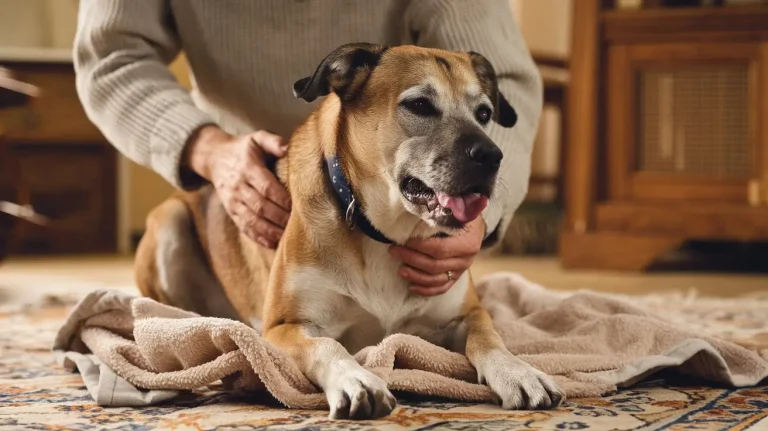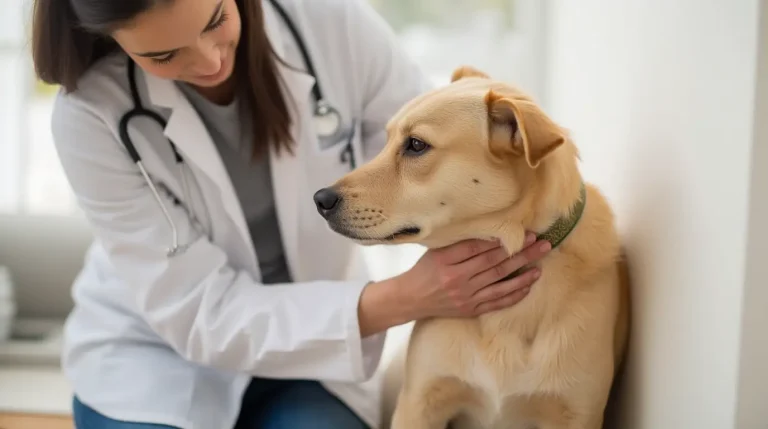Discovering that your beloved dog is vomiting white foam can be alarming and confusing for any pet owner. Whether it happens suddenly or persists over time, this symptom often raises concerns about your furry friend’s health. But what exactly causes a dog to vomit white foam, and should you panic? While white foam vomit isn’t always indicative of a serious issue, it can sometimes signal an underlying medical condition that requires attention.
In this article, we’ll explore the common causes behind dog vomiting white foam, discuss effective treatment options, and help you understand when it’s time to consult a veterinarian. By the end, you’ll have a clearer understanding of how to address this concerning symptom and ensure your dog stays happy and healthy.
Table of Contents
What Causes Dog Vomiting White Foam?
When your dog starts vomiting white foam, it can be unsettling, but understanding the possible causes is the first step toward addressing the issue. Below, we’ll break down the common reasons behind this symptom and help you differentiate between minor concerns and more serious conditions.
Common Reasons Behind White Foam Vomiting in Dogs
- Gastric Irritation
Gastric irritation, often caused by an empty stomach or excessive stomach acid production, can lead to your dog vomiting white foam. This is especially common in dogs that go long periods without eating or those prone to acid reflux. Feeding smaller, more frequent meals may help alleviate this issue. - Bile Reflux
Bile reflux occurs when bile from the small intestine flows back into the stomach, causing discomfort and leading to foamy vomit. This condition is often seen in dogs with digestive issues or those that vomit on an empty stomach. Managing feeding schedules and consulting a vet for proper treatment can help resolve this problem. - Eating Spoiled Food or Grass
Dogs are curious creatures and may ingest spoiled food, plants, or grass, which can irritate their stomach lining and cause them to vomit white foam. While occasional grass-eating is normal, if your dog frequently vomits after consuming foreign objects, it could indicate a dietary issue or boredom. - Stress or Anxiety
Stress and anxiety can manifest physically in dogs, sometimes leading to gastrointestinal upset and vomiting. Events like thunderstorms, separation anxiety, or changes in routine can trigger this response. Identifying and addressing the source of stress can help reduce these symptoms. - Foreign Object Ingestion
If your dog has swallowed something indigestible, such as a toy, bone, or fabric, it could block their digestive tract and cause vomiting. In some cases, this obstruction might lead to white foam due to irritation or difficulty digesting the object.
Medical Conditions That May Lead to Foamy Vomit
In addition to the above, certain medical conditions can also cause your dog to vomit white foam. Here are a few possibilities:
- Kennel Cough
Kennel cough, a highly contagious respiratory infection, can cause dogs to produce excessive saliva and foam at the mouth. While not directly related to digestion, the coughing and gagging associated with this condition can mimic vomiting. - Acid Reflux
Similar to gastric irritation, acid reflux involves the backward flow of stomach acid into the esophagus, causing discomfort and vomiting. Chronic acid reflux may require medication prescribed by a veterinarian. - Pancreatitis
Pancreatitis, or inflammation of the pancreas, can cause nausea, vomiting, and abdominal pain. If your dog is vomiting white foam alongside lethargy or loss of appetite, pancreatitis could be a potential cause. - Liver Disease
Liver disease affects how the body processes toxins and nutrients, potentially leading to vomiting and other symptoms. If your dog’s white foam vomit is accompanied by yellowing eyes or gums (jaundice), liver disease should be investigated. - Poisoning
Exposure to toxic substances, such as household cleaners, plants, or human medications, can cause severe vomiting, including white foam. If you suspect poisoning, seek emergency veterinary care immediately.
When Is It Just Indigestion vs. Something More Serious?
Differentiating between minor issues and serious conditions is crucial when dealing with dog vomiting. Indigestion or mild gastric irritation may resolve on its own with rest and hydration, while persistent or severe symptoms warrant immediate attention. Consider the following factors:
- Frequency: Occasional vomiting is usually less concerning than frequent episodes.
- Accompanying Symptoms: Look for signs like diarrhea, lethargy, dehydration, or blood in the vomit, which may indicate a more serious issue.
- Behavior Changes: A dog that continues to eat, drink, and act normally despite vomiting is likely experiencing a minor problem. However, significant behavioral changes should not be ignored.
If you’re unsure whether your dog’s vomiting is a sign of something serious, it’s always best to err on the side of caution and consult your veterinarian for a professional diagnosis
Treating Dog Vomiting White Foam at Home
While dog vomiting white foam can sometimes be managed at home, it’s important to approach the situation carefully and monitor your pet closely. Below, we’ll outline the initial steps you can take, suggest some home remedies for mild cases, and explain when professional veterinary care is necessary.
Initial Steps to Take
When your dog begins vomiting white foam, the first step is to assess their condition and provide basic care to prevent further complications.
- Withhold Food Temporarily (Dietary Changes)
Fasting your dog for 12-24 hours can help give their digestive system a rest and allow any irritation or inflammation to subside. During this time, avoid giving them food but ensure they have access to fresh water. This temporary fasting is especially useful if the vomiting seems related to overeating, dietary indiscretion, or minor gastric upset. - Provide Fresh Water to Prevent Dehydration (Symptom)
Vomiting can quickly lead to dehydration, which may worsen your dog’s condition. Offer small amounts of fresh water frequently to keep them hydrated. If your dog refuses to drink or continues vomiting after consuming water, consult your vet immediately, as severe dehydration requires medical intervention.
Home Remedies for Mild Cases
If the vomiting appears to be mild and your dog seems otherwise healthy, you can try these home remedies to alleviate their discomfort:
- Offer Bland Diets (e.g., Boiled Chicken and Rice)
After the fasting period, reintroduce food gradually with a bland diet. Boiled chicken (skinless and boneless) mixed with plain white rice is a popular option that’s easy on the stomach. You can also add a bit of plain canned pumpkin (not pie filling) to aid digestion. Feed small portions every few hours to avoid overwhelming their system. - Use Probiotics for Dogs (Treatment)
Probiotics can help restore the balance of good bacteria in your dog’s gut, promoting healthier digestion. Look for probiotic supplements specifically formulated for dogs, or consult your vet for recommendations. Adding probiotics to their diet may reduce nausea and improve overall gastrointestinal health.
When Not to Attempt Home Treatment
While home treatments can be effective for mild cases, there are situations where attempting to treat your dog at home could delay necessary medical care. Seek veterinary attention immediately if:
- The vomiting persists for more than 24 hours.
- Your dog shows signs of dehydration, such as dry gums, sunken eyes, or lethargy.
- There is blood in the vomit or stool.
- Your dog exhibits other concerning symptoms, such as severe abdominal pain, loss of appetite, or diarrhea.
- You suspect poisoning or ingestion of a foreign object.
- Your dog has a pre-existing medical condition, such as kidney disease, liver disease, or diabetes.
Attempting to manage these conditions at home without professional guidance can put your dog’s health at risk. A veterinarian will be able to diagnose the underlying cause and recommend appropriate treatment options.
When Should You Worry About Dog Vomiting White Foam?
While occasional vomiting of white foam may not always indicate a serious issue, certain signs and symptoms warrant immediate attention. Recognizing these red flags can help you determine when it’s time to consult your veterinarian for further evaluation and treatment.
Signs That Indicate a Veterinary Visit Is Necessary
If your dog is vomiting white foam and exhibits any of the following symptoms, it’s important to schedule a vet appointment as soon as possible:
- Persistent Vomiting (Symptom)
If your dog continues to vomit white foam for more than 24 hours, this could signal an underlying condition that requires medical intervention. Prolonged vomiting can lead to dehydration and other complications, making timely diagnosis crucial. - Lethargy or Weakness (Symptom)
A lack of energy or unusual tiredness may indicate that your dog is feeling unwell. Lethargy combined with vomiting could point to a more serious issue, such as infection, poisoning, or organ dysfunction. - Loss of Appetite (Symptom)
Refusal to eat or drink despite showing interest in food can be concerning. This behavior might suggest nausea, pain, or another health problem that needs addressing. - Diarrhea or Blood in Vomit (Symptom)
The presence of diarrhea or blood in your dog’s vomit indicates significant gastrointestinal distress. Blood may appear bright red or dark and tarry, depending on its source, and should never be ignored.
Emergency Situations to Watch For
Some conditions require immediate emergency care to prevent life-threatening consequences. Be vigilant for the following signs:
- Bloat/GDV (Disease/Condition)
Bloat, also known as Gastric Dilatation-Volvulus (GDV), is a life-threatening condition where the stomach fills with gas and twists. Symptoms include a distended abdomen, retching without producing vomit, restlessness, and rapid breathing. If you suspect bloat, seek emergency veterinary care immediately. - Severe Abdominal Pain (Symptom)
Dogs in severe abdominal pain may cry out, pant excessively, or assume a hunched posture. This could indicate issues like pancreatitis, intestinal blockages, or other critical conditions. - Suspected Poisoning (Cause)
Exposure to toxic substances, such as household cleaners, plants, or human medications, can cause vomiting and other dangerous symptoms. If you suspect poisoning, contact your vet or an animal poison control center right away.
What Your Vet Will Do
When you bring your dog to the vet for vomiting white foam, they will conduct a thorough examination to identify the underlying cause. Here’s what you can expect:
- Diagnosis Methods
- Physical Examination: The vet will assess your dog’s overall health, checking for signs of dehydration, pain, or discomfort.
- Blood Tests: These tests can detect infections, liver or kidney issues, or electrolyte imbalances.
- X-rays or Ultrasounds: Imaging studies may be used to look for foreign objects, tumors, or structural abnormalities in the digestive tract.
- Fecal Analysis: Testing stool samples can help rule out parasites or bacterial infections.
- Possible Treatments
Depending on the diagnosis, your vet may recommend one or more of the following treatments:- Medication: Anti-nausea drugs, antibiotics, or antacids may be prescribed to alleviate symptoms and address specific conditions.
- Hydration Therapy: Intravenous (IV) fluids can rehydrate your dog and restore electrolyte balance if dehydration is present.
- Dietary Adjustments: A prescription diet or special feeding plan may be recommended to support recovery.
- Surgical Intervention: In cases involving foreign object ingestion, bloat, or other surgical emergencies, surgery may be necessary to resolve the issue.
Preventive Measures to Avoid Future Incidents
Preventing future incidents of dog vomiting white foam involves adopting a proactive approach to your pet’s health. By implementing simple yet effective strategies, you can minimize the risk of this concerning symptom recurring and ensure your furry friend stays happy and healthy.
Tips for Keeping Your Dog Healthy
- Monitor Diet and Avoid Table Scraps
A well-balanced diet is essential for maintaining your dog’s digestive health. Feeding them high-quality dog food that meets their nutritional needs reduces the likelihood of gastrointestinal upset. Avoid giving table scraps, as human foods can be difficult for dogs to digest and may even contain ingredients toxic to them. Additionally, establish a consistent feeding schedule to prevent overeating or prolonged periods without food, both of which can contribute to gastric irritation. - Reduce Stress and Anxiety Triggers (Cause)
Stress and anxiety are common causes of digestive issues in dogs, including vomiting white foam. Identify potential stressors in your dog’s environment, such as loud noises, separation anxiety, or changes in routine, and work to mitigate these triggers. Providing enrichment activities like puzzle toys, regular exercise, and positive reinforcement training can help keep your dog mentally and physically stimulated, reducing stress levels. - Regular Vet Check-Ups
Routine veterinary visits are crucial for catching potential health issues before they escalate. During check-ups, your vet can assess your dog’s overall health, update vaccinations, and screen for underlying conditions that might predispose them to vomiting or other symptoms. Early detection of problems allows for timely intervention and better outcomes.
Importance of Early Detection
Recognizing symptoms early is one of the most important aspects of responsible pet ownership. Many serious conditions, such as pancreatitis, liver disease, or poisoning, can be effectively managed if caught in their initial stages. Here’s why early detection matters:
- Prevents Progression: Identifying and addressing issues early prevents minor problems from developing into more severe conditions that could jeopardize your dog’s life.
- Improves Prognosis: Timely treatment often leads to faster recovery and better long-term health outcomes.
- Reduces Costs: Addressing health concerns early typically requires less extensive—and less expensive—treatment compared to advanced-stage interventions.
By staying vigilant and monitoring your dog’s behavior and physical condition, you can spot warning signs sooner and act quickly to protect their well-being.
Conclusion
Discovering that your dog is vomiting white foam can be alarming, but understanding the causes, treatments, and warning signs empowers you to take the right steps for their health. In this article, we’ve covered several key points:
- Causes: From gastric irritation and bile reflux to more serious conditions like pancreatitis or poisoning, there are many reasons why dogs vomit white foam. Identifying the underlying cause is critical.
- Treatments: For mild cases, home remedies such as fasting, offering bland diets, and using probiotics can help. However, persistent or severe symptoms require immediate veterinary attention.
- Warning Signs: Persistent vomiting, lethargy, diarrhea, blood in vomit, or signs of bloat are red flags that demand urgent care.
To ensure your dog stays healthy, always consult a vet if you’re unsure about the severity of their condition. Early intervention can make all the difference in preventing complications and ensuring a swift recovery.
We encourage you to share this article with fellow pet owners who may benefit from the information. Together, we can promote better awareness and care for our furry friends!
FAQ
Q1: Why is my dog throwing up white foam but acting normal?
If your dog is vomiting white foam but otherwise seems fine, it could be due to minor issues like an empty stomach causing acid buildup or eating grass. However, even if they appear normal, monitor them closely for additional symptoms. If the vomiting continues or worsens, consult your vet to rule out underlying conditions.
Q2: Can stress cause dogs to vomit white foam?
Yes, stress and anxiety can lead to gastrointestinal upset in dogs, including vomiting white foam. Events like thunderstorms, separation anxiety, or changes in routine might trigger this response. Reducing stress through calming techniques, exercise, and mental stimulation can help alleviate these symptoms.
Q3: Is dog vomiting white foam always serious?
Not necessarily. Occasional vomiting of white foam isn’t always a cause for concern and may result from minor issues like indigestion or eating grass. However, persistent vomiting, especially when accompanied by other symptoms like lethargy, dehydration, or blood in vomit, indicates a more serious problem requiring veterinary attention.
Q4: What should I feed my dog after they vomit white foam?
After vomiting, withhold food for 12-24 hours to give your dog’s digestive system a rest. Once the fasting period is over, reintroduce food gradually with a bland diet, such as boiled chicken and rice. Avoid rich or spicy foods, and ensure your dog has access to fresh water at all times. If symptoms persist, seek advice from your vet before making dietary changes.





